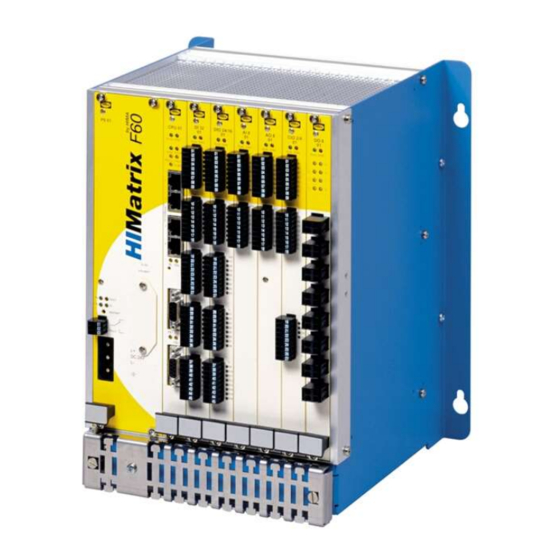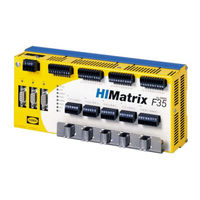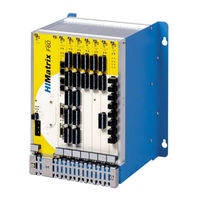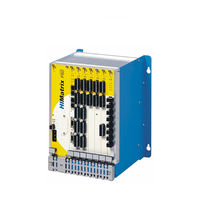
HIMA HIMatrix F60 Controller module Manuals
Manuals and User Guides for HIMA HIMatrix F60 Controller module. We have 6 HIMA HIMatrix F60 Controller module manuals available for free PDF download: Manual, System Manual, Safety Manual, Engineering Manual
HIMA HIMatrix F60 System Manual (110 pages)
Safety-Related Controller Compact Systems
Brand: HIMA
|
Category: Controller
|
Size: 1.29 MB
Table of Contents
-
Safety11
-
Intended Use11
-
Scope11
-
Power Supply14
-
Line Control16
-
Product Data20
-
Safeethernet21
-
Sntp24
-
Modbus TCP24
-
Silworx27
-
Programming29
-
User Program30
-
Multitasking31
-
Time Limits42
-
Start-Up44
-
Definitions44
-
Mounting46
-
Shielding51
-
Online Test92
-
Operation93
-
Handling93
-
Diagnosis93
-
Maintenance96
Advertisement
HIMA HIMatrix F60 Manual (114 pages)
Safety-Related Controller
Brand: HIMA
|
Category: Controller
|
Size: 1.2 MB
Table of Contents
-
Safety Notes11
-
Safety13
-
Intended Use13
-
Scope13
-
Power Supply16
-
Modules18
-
Inputs18
-
Outputs19
-
Line Control19
-
Product Data23
-
Safeethernet25
-
Sntp28
-
Modbus TCP28
-
Silworx31
-
Programming33
-
User Program34
-
Multitasking35
-
Time Limits46
-
Start-Up48
-
Definitions48
-
Mounting49
-
Shielding53
-
Online Test96
-
Operation97
-
Handling97
-
Diagnosis97
-
Maintenance100
-
Interferences100
-
Replacing Fans100
HIMA HIMatrix F60 Safety Manual (72 pages)
Safety-Related Controller
Brand: HIMA
|
Category: Controller
|
Size: 0.6 MB
Table of Contents
-
-
Scope10
-
Power Supply12
-
-
-
Padt16
-
Proof Test18
-
Programming19
-
-
Self-Tests24
-
RAM Test24
-
5 Inputs
26-
General26
-
General27
-
Line Control28
-
General29
-
General32
-
-
6 Outputs
33-
General33
-
Line Control34
-
-
-
-
Procedures48
-
Forcing54
-
Time Limits55
-
Force Editor56
-
Remote I/O)56
-
Online Test57
-
-
Terms63
Advertisement
HIMA HIMatrix F60 Engineering Manual (64 pages)
HIMatrix System Automation Devices
Brand: HIMA
|
Category: Control Unit
|
Size: 1.89 MB
Table of Contents
-
-
Mechanical12
-
-
-
Wiring36
-
6 Labeling
43 -
HIMA HIMatrix F60 Manual (38 pages)
Safety-Related Controller
Brand: HIMA
|
Category: Controller
|
Size: 0.62 MB
Table of Contents
-
2 Safety
9 -
-
Type Label13
-
Structure14
-
Front View15
-
Product Data17
-
4 Start-Up
18-
Cable Plugs19
-
Module Slots21
-
Tab: Module22
-
5 Operation
27 -
8 Transport
30
HIMA HIMatrix F60 Manual (38 pages)
Safety-Related Controller
Brand: HIMA
|
Category: Controller
|
Size: 0.61 MB
Table of Contents
-
2 Safety
9 -
-
Line Control11
-
Type Label12
-
Structure13
-
Front View14
-
I/O Leds15
-
Product Data16
-
4 Start-Up
17-
Cable Plugs19
-
Module Slots21
-
Inputs22
-
Tab Module23
-
5 Operation
27 -
8 Transport
30
Advertisement





